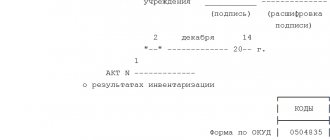LEGAL REQUIREMENTS REGARDING INVENTORY OF ACCOUNTS RECEIVABLE
It is necessary to timely inventory accounts receivable for a number of important reasons. Firstly , this is a legal requirement. According to paragraph 1 of Art. 11 of Federal Law No. 402-FZ dated December 6, 2011 (as amended on November 28, 2018) “On Accounting” (hereinafter referred to as Federal Law No. 402-FZ), assets and liabilities are subject to inventory.
Secondly , current data is needed for management accounting purposes. It is impossible to draw the right conclusions and make the right decisions if you have outdated information. Thirdly , inventory as one of the forms of control over the amount of accounts receivable is very important in order to maintain the required amount of working capital of the enterprise.
It would be irrational to make different inventories for different purposes. One for accounting, the second for management, etc. The inventory results must be impeccably documented so that they are recognized by third parties - counterparties, tax authorities, courts.
For whatever reasons an inventory of payments is carried out, it is important to know and comply with the legal requirements in this regard. Therefore, let us familiarize ourselves with the relevant provisions of regulations.
According to clause 27 of the Order of the Ministry of Finance of Russia dated July 29, 1998 No. 34n (as amended on April 11, 2018) “On approval of the Regulations on accounting and financial reporting in the Russian Federation,” inventory is mandatory :
- when transferring property for rent, redemption, sale;
- when transforming a state or municipal unitary enterprise;
- before drawing up annual financial statements (except for property, the inventory of which was carried out no earlier than October 1 of the reporting year);
- when changing financially responsible persons (on the day of acceptance and transfer of cases);
- when facts of theft, abuse or damage to property are revealed (immediately upon establishment of such facts);
- in the event of a natural disaster, fire or other emergency situations caused by extreme conditions (immediately after the end of the fire or natural disaster);
- during reorganization or liquidation of the organization;
- in other cases provided for by the legislation of the Russian Federation.
Similar norms are contained in clause 1.5 of the Order of the Ministry of Finance of Russia dated June 13, 1995 No. 49 (as amended on November 8, 2010) “On approval of the Methodological Guidelines for the Inventory of Property and Financial Liabilities.”
An important point: inventory is carried out not only in cases established by regulatory legal acts. Inventory at an enterprise can be carried out in other cases, as well as at other times.
The cases, timing and procedure for conducting an inventory, as well as the list of objects subject to inventory, are determined by the economic entity, with the exception of the mandatory inventory (Article 11 of Federal Law No. 402-FZ).
The manager, due to the specifics of the activities of his enterprise and the characteristics of the production process, determines with what frequency and in what time frame it is advisable to carry out inventories, as well as the procedure for their implementation.
This point is specified in the order on the accounting policy of the enterprise. This is a legal requirement. Clause 4 of the Accounting Regulations “Accounting Policy of the Organization” (PBU 1/2008), approved by Order of the Ministry of Finance of Russia dated October 6, 2008 No. 106n (as amended on April 28, 2017) instructs an economic entity, when developing an accounting policy, to provide for the procedure for conducting an inventory of assets and obligations.
To carry out inventory, the enterprise creates a permanent (working) inventory commission, the composition of which is approved by the head of the organization. The commission may include accounting and administrative staff, economists, representatives of the internal audit service or independent audit organizations.
NOTE
To carry out an inventory, the presence of all members of the inventory commission is necessary. The absence of at least one member of the commission serves as grounds for declaring the inventory results invalid.
The inventory is preceded by the issuance of an order to conduct an inventory. Resolution of the State Statistics Committee of Russia dated August 18, 1998 No. 88 (as amended on May 3, 2000) “On approval of unified forms of primary accounting documentation for recording cash transactions and recording inventory results” approved a special form of such an order - No. INV-22 .
An important point: from 01/01/2013, the forms of primary accounting documents contained in albums of unified forms of primary accounting documentation are not mandatory for use. In this regard, the enterprise can issue an order (decree, instruction) to conduct an inventory in any form. The main thing is to comply with legal requirements regarding the availability of mandatory document details.
The order under consideration appoints the chairman and members of the inventory commission, indicates the specific object of the inventory, the timing of its implementation and the date of submission of materials to the accounting department.
The order (resolution, instruction) is signed by the head of the organization and handed over to the chairman of the inventory commission. It must be registered in the Logbook for monitoring the implementation of orders (decrees, instructions) on inventory ( form No. INV-23 ).
When to inventory accounts receivable
The frequency of conducting a comprehensive inventory of property and liabilities is established by Art. 2.1 Methodological guidelines for conducting an inventory (approved by order of the Ministry of Finance dated June 13, 1995 No. 49). At the same time, under certain circumstances, it may be necessary to take inventory of a separate component of the enterprise’s assets—accounts receivable (AR). Examples of such circumstances include the following:
- accumulation of outstanding debts of counterparties over a long period, stipulated in contracts and characteristic of the rules of business turnover in a particular area of business;
- the specifics of the enterprise’s activities, in which the main part of the assets is made up of remote assets (for example, activities related to issuing loans or investment activities);
- lack of working capital as a result of funds being stuck in the debts of counterparties;
- deterioration of financial indicators according to accounting or management reporting (for example, the turnover ratio of a subsidiary).
The formula for calculating the turnover of remote control can be found here.
ConsultantPlus experts explained how to correctly and with what documents record the write-off of receivables in tax accounting:
If you do not have access to the K+ system, get a trial online access for free.
FEATURES OF INVENTORY OF ACCOUNTS RECEIVABLE
The main purpose of inventory of accounts receivable is to check the validity of the amounts in the accounting accounts. Accounts receivable can arise and be accounted for in the following accounting accounts:
- 60 “Settlements with suppliers and contractors”;
- 62 “Settlements with buyers and customers”;
- 68 “Calculations for taxes and fees”;
- 69 “Calculations for social insurance and security”;
- 70 “Settlements with personnel for wages”;
- 71 “Settlements with accountable persons”;
- 73 “Settlements with personnel for other operations”;
- 75 “Settlements with founders”;
- 76 “Settlements with various debtors and creditors.”
Arrears must be confirmed by primary documents: contracts, invoices, certificates of work performed (services rendered), universal transfer documents ( UTD ), salary statements, payment orders, cash receipts and debit orders, advance reports, accounting statements, etc. .
Inventory of calculations: procedure and timing of inventory
As a general rule, before drawing up the final financial statements for the year, the organization is obliged to conduct an inventory of total assets and liabilities (clause 27 of the Regulations on accounting and financial reporting in the Russian Federation, approved by order of the Ministry of Finance of Russia dated July 29, 1998 No. 34n), in particular settlements with debtors and creditors.
For information on inventory before generating final reporting, read the article “How to conduct an inventory before annual reporting .
Find out what you need to do before starting the inventory in the Ready-made solution from ConsultantPlus. Trial access to the system is provided free of charge.
In addition, the inventory can be carried out in other cases by decision of the manager. Such a case, for example, could be the preparation of reports for a potential investor or board of directors, at which strategic issues of the company’s development will be decided.
Test yourself: how to take an inventory. Completion time: about 5 minutes. Take the test
At the same time, it is important for the company to objectively understand what volumes of debt receivable can be counted on and in what period, as well as what the actual volumes of the company’s creditors to counterparties are. In other words, it is necessary to correctly conduct an inventory of settlements with debtors and creditors.
Inventory of calculations consists of reconciling the values listed in the relevant accounting accounts, assessing the validity of their reflection, as well as checking the debt for overdue status.
The inventory of settlements is carried out within the time limits specified in the internal document (clause 2.1 of the Methodological Instructions for Inventory, approved by Order of the Ministry of Finance of Russia dated June 13, 1995 No. 49).
Find out how to properly conduct an inventory of settlements with debtors and creditors in the Typical Situation from ConsultantPlus. If you do not have access to the K+ system, get a trial online access for free.
In order to carry out an inventory of payments, the company, as a general rule, must form a special inventory commission operating on an ongoing basis (clause 2.2 of the Methodological Instructions). Such a commission may include employees of the administrative departments of the company, accounting, as well as other departments (legal, financial, etc.). At its discretion, the company has the right to include employees of audit structures (both internal and external) in the commission.
The inventory of settlements is formalized by order of the manager (form INV-22), which, in particular, indicates the grounds for its implementation, the timing, and the composition of the commission.
IMPORTANT! If at least one member of the commission is not present during the actual inventory, the results of such an inspection will be considered invalid (clause 2.3 of the Guidelines).
After reconciling settlements with debtors and creditors and identifying the current scale of debt, the company must correctly document the results of the inventory of settlements. For this purpose, unified forms of primary documents are provided in the appendices to the Methodological Instructions.
One of these forms (Appendix 16) is the act of inventory of settlements with suppliers, buyers and other debtors and creditors (Form INV-17). It is advisable for the company to formalize the results of checking the volume of debt with this act.
If an inventory of calculations is carried out before preparing annual reports, then its results must be reflected in the financial statements for the year. If the inventory of calculations is carried out for other reasons, then its results are subject to reflection in the accounting and reporting of the month in which it was completed (clause 5.5 of the Methodological Instructions approved by Order of the Ministry of Finance of Russia dated June 13, 1995 No. 49).
INVENTORY OF ACCOUNTS RECEIVABLE FOR WAGES AND ACCOUNTABLE PERSONS
During the inventory of receivables for wages, in addition to confirming the validity of the amounts listed, the reasons for the overpayment are established. They check the primary documents that served as the basis for the payment. In this case, there is no need to carry out an inventory of receivables for wages with a complete check of labor calculations. Accruals and payments are verified only to the extent necessary to confirm the validity and reality of the debts.
It is necessary to find out whether there are any debts owed by dismissed employees, to assess the reality of the amounts listed and the possibility of repaying them by returning funds from the employee or offsetting them with accruals for the reporting period.
Accountable persons control the dates of payments and the intended purpose. They check whether the dismissed employees have any outstanding debts. Find out whether accountable advances are overdue. The debt will be overdue if the deadline for submitting the advance report has expired.
According to clause 6.3 of the Bank of Russia Directive No. 3210-U dated March 11, 2014 (as amended on June 19, 2017) “On the procedure for conducting cash transactions by legal entities and the simplified procedure for conducting cash transactions by individual entrepreneurs and small businesses,” the accountable entity is obliged to , not exceeding three working days after the expiration date for which cash was issued on account, or from the date of going to work, present to the chief accountant or accountant (in their absence - to the manager) an advance report with attached supporting documents. An important point: the deadline for the report is set by the head of the enterprise.
The commission examines the availability of documents confirming the intended use of the amounts issued, payments to the employee and refunds, if any.
INVENTORY OF ACCOUNTS RECEIVABLES OF SUPPLIERS AND BUYERS
For advances to suppliers, the relevant documents are checked - the basis for such payments (invoices, contracts, memos). It is advisable to check the availability of all necessary approvals at the enterprise in accordance with internal regulations regarding payments made.
The process of confirming the validity of amounts for suppliers and buyers will involve the formation of special documents - reconciliation reports in the context of the calculations being carried out.
The reconciliation report indicates in chronological order all transactions for a given partner, an agreement with him, or another basis. Then the total settlement amounts for the reconciled period are displayed. For suppliers, these are the amounts of payments and the receipt of goods, works, services; for buyers, these are payments and shipment of products, performance of work, provision of services. Based on this data, the final amount of debt is derived in favor of one or the other party.
The reconciliation report is signed by the head of the enterprise, and by proxy - by any person authorized by him. Having a power of attorney for an authorized person is very important. Thus, in the Determination of the Supreme Arbitration Court of the Russian Federation dated August 21, 2013 No. VAS-11147/13 in case No. A67-6327/2012 it is stated that by virtue of Art. 53 of the Civil Code of the Russian Federation (hereinafter referred to as the Civil Code of the Russian Federation), the chief accountant is not a person entitled to act on behalf of the enterprise without a power of attorney. The reconciliation act can be signed as authorized persons by the sole executive body of the defendant or by a representative acting on the basis of a power of attorney issued by such body, which contains the authority to perform a particular action.
If there is no power of attorney in the file confirming the authority of the chief accountant to acknowledge the debt, his signature on the reconciliation act does not constitute an acknowledgment of the debt by the defendant; the act itself is a basis for interrupting the limitation period.
If the counterparty agrees with the data given in the reconciliation report, he also signs this document. If there are discrepancies, the partner indicates his data and his results. In this case, you have to check the validity of its amounts and clarify whether an error has crept into your own accounting.
In a similar way, an inventory of the amounts of “receivables” listed on account 76 “Settlements with various debtors and creditors” is carried out.
It is advisable to highlight debt incurred in connection with the sale of goods, performance of work, and provision of services. The fact is that only for such debt the Tax Code of the Russian Federation (hereinafter referred to as the Tax Code of the Russian Federation) allows the creation of a reserve for doubtful debts. For the purpose of possible formation of such a reserve, it is better to provide in advance for the separate allocation of such debts.
INVENTORY OF ACCOUNTS RECEIVABLE OF THE FTS OF THE RF AND OFF-BUDGETARY FUNDS
It is impossible to get by with formal confirmation of the validity of the amounts taken into account for these entities. It is necessary to assess the reasons for the overpayment, whether it is possible to return it from the budget or offset it against other taxes, whether it is worth starting a long process of return or whether the overpayment will be taken into account in the reporting tax liabilities.
To reconcile with the budget, you can use certificates issued by the tax authority (the form of a certificate on the status of settlements for taxes, fees, penalties, fines, interest of organizations and individual entrepreneurs is given in Order of the Federal Tax Service of Russia dated December 28, 2016 No. ММВ-7-17 / [email protected ] “On approval of forms of certificates on the status of settlements for taxes, fees, insurance premiums, penalties, fines, interest, the procedure for filling them out and formats for submitting certificates in electronic form”). You can also order a reconciliation report.
What is debt inventory?
The procedure involves reconciliation with counterparties in order to clarify the amounts of the parties’ obligations to each other, as well as to identify overdue debts.
In the “receivables” part, debts and advances to:
- suppliers and contractors;
- staff;
- accountables;
- founders;
- budget and extra-budgetary funds.
When taking inventory of accounts payable, the following is determined:
- obligations to pay for goods (works, services) received;
- debt to personnel;
- status of settlements with the budget;
- status of settlements for deliveries of goods received from counterparties on account of advances.
To carry out an inventory, the head of the company must form an inventory commission operating on a permanent basis with the specified composition. To do this, an appropriate order should be issued. The commission can include employees of accounting departments, administrative departments or audit structures. If the volume of liabilities and assets is small, the audit commission has the right to carry out the procedure.
The procedure for conducting an inventory of receivables and payables must be prescribed in the accounting policies of the organization.
The objectives of the inventory are:
- documentary evidence of the amounts of existing debt;
- an assessment of how likely the debt is to be repaid.
INVENTORY OF OTHER ACCOUNTS RECEIVABLE
During the inventory, the validity of the debts of the organization’s personnel for issued loans, for compensation for various material damage caused to the organization, the debt of LLC participants (joint-stock shareholders) for payment of shares (shares), for the amounts of overpaid dividends, etc. is checked.
The timing of the formation of these amounts, the reasons and reality of existing debts, as well as the possibility of collecting them are clarified. As a result, the inventory commission, through a documentary check, must establish the correctness and validity of :
- the amount of accounts receivable listed in the accounting records, including debt for shortages and thefts;
- amounts of receivables, including amounts of “receivables” with an expired statute of limitations.
FOR YOUR INFORMATION
The general limitation period is three years (Article 196 of the Civil Code of the Russian Federation), and the limitation period begins from the day when the person learned or should have learned about the violation of his right and who is the proper defendant in the claim for the protection of this right ( Article 200 of the Civil Code of the Russian Federation).
It is important to take into account that in accordance with Art. 203 of the Civil Code of the Russian Federation, the limitation period is interrupted by the obligated person taking actions indicating recognition of the debt.
In paragraph 20 of the Resolution of the Plenum of the Supreme Court of the Russian Federation dated September 29, 2015 No. 43 (as amended on February 7, 2017) “On some issues related to the application of the norms of the Civil Code of the Russian Federation on the limitation period” it is stated that actions indicating the recognition of a debt in order to interrupt the limitation period, may include: recognition of the claim; a change in the contract by an authorized person, from which it follows that the debtor acknowledges the existence of a debt, as well as a request from the debtor for such a change in the contract (for example, a deferment or installment plan); act of reconciliation of mutual settlements, signed by an authorized person.
A response to a claim that does not contain an indication of the acknowledgment of a debt does not in itself indicate an acknowledgment of a debt. Recognition of a part of the debt, including by paying part of it, does not indicate recognition of the debt as a whole, unless otherwise agreed by the debtor.
After the break, the limitation period begins anew; the time elapsed before the break does not count towards the new term.
Thus, the following fact must be taken into account: by approving the reconciliation act and fulfilling the legal requirements regarding the inventory, the organization resets the already expired statute of limitations.
NOTE
If the debtor is excluded from the Unified State Register of Legal Entities, then all his obligations at the moment have been terminated, and therefore there are no legal grounds for calculating the limitation period after this date (Resolution of the Arbitration Court of the Moscow District dated November 7, 2017 No. F05-16302/2017 in case No. A40-106253/2016).
In addition to formal confirmation of the validity of the debt amounts recorded during the inventory, it is necessary to highlight doubtful accounts receivable . Signs of such debt:
- lack of contact with the counterparty;
- significant delay in fulfillment of contractual obligations;
- the appearance in the extract from the Unified State Register of Legal Entities of information about the unreliability of data;
- large amounts of debt to the Federal Tax Service of Russia;
- blocking of current accounts;
- signs ;
- lack of property, etc.
In order to control the limitation period, it is important to identify the start date of the limitation period, the expired limitation period, taking into account the interruption in the running of the period.
What are the goals of the remote sensing inventory?
Carrying out an inventory of remote control should help solve problems such as:
- Determining the actual presence of debt in an enterprise - it is necessary to make sure that the amounts of debts reflected in accounting and reporting are real and are actually existing debts (and not, for example, the result of accounting errors or slow reflection of data in accounting).
IMPORTANT! When carrying out an inventory of remote control, the debit balance of not only account 62 is analyzed, but also other accounts intended for accounting for settlements with contractors and personnel: 60, 70, 71, 73.
How to analyze accounts receivable, read in this material.
- Identification of counterparties that are not actually debtors: for example, if the same counterparty has both receivables and comparable payables and it is possible to set off. Offsetting homogeneous claims
- Reflection of correct inventory data in enterprise accounting.
For more information on how to reflect inventory results, see the article “Reflecting inventory results in accounting .
- Development of methods for obtaining (collecting) actually existing doubtful debts:
- claim work;
- agreeing on the possibility of installment plans or debt restructuring with the counterparty;
- lawsuits if pre-trial measures have not yielded results;
- possibility of selling debts.
- Identification of a debt that can no longer be collected, for example, the statute of limitations has passed (Article 196 of the Civil Code of the Russian Federation) or the debtor organization has been liquidated (Article 419 of the Civil Code of the Russian Federation). Such debt then undergoes a separate write-off procedure.
When receivables are considered overdue, find out here.
- Based on the results of the inventory, a set of measures for effective control and management of remote sensing in the future can also be developed and implemented.
IMPORTANT! In addition to balance sheet accounts, the inventory of receivables must also cover off-balance sheet accounts. Account 007 is intended to record written off bad debts for which there may still be a chance to receive something. When drawing up an overall picture of debts, data on account 007 should also be taken into account.
For more information on this, see the article “Is it possible to carry out an inventory for off-balance sheet accounts? ”
EXAMPLE OF INVENTORY OF ACCOUNTS RECEIVABLE
According to accounting data, Universal LLC includes the following amounts of accounts receivable in the context of synthetic accounting accounts (Table 1).
| Table 1. Extract from the balance sheet of the enterprise as of 04/30/2019 | |
| Account | Debit balance, rub. |
| 60 “Settlements with suppliers and contractors” | 1 720 165 |
| 62 “Settlements with buyers and customers” | 4 757 874 |
| 68 “Calculations for taxes and fees” | 310 000 |
| 69 “Calculations for social insurance and security” | 302 |
| 70 “Settlements with personnel for wages” | 18 475 |
| 71 “Settlements with accountable persons” | 94 000 |
| Total | 6 900 816 |
On 05/06/2019, the director of the enterprise, Ivanov R.I., issued an order according to which, from May 6 to May 10, 2022, the working inventory commission must conduct an inventory of settlements in relation to the amounts of the enterprise’s receivables. Documents must be submitted to the accounting department on May 10, 2019.
Fulfilling this order, the accountant prepared reconciliation reports with each counterparty.
Based on reconciliation reports and primary documentation, the following was established. According to settlements with suppliers and contractors, there are errors in accounting data . The accounting department did not reflect the invoice presented by the supplier in April 2019 in the amount of RUB 74,590. for the supplied materials necessary for Universal LLC to provide services.
It was also revealed that the debt in the amount of 168,575 rubles. is real, but it was not possible to obtain signed reconciliation reports with suppliers for various technical reasons. Debt in the amount of 203,450 rubles. was classified as unreal (due to the expiration of the statute of limitations for one enterprise, or the exclusion of an organization from the Unified State Register of Legal Entities - in another way).
Another 303,000 rubles. were recognized as a doubtful debt, since it was possible to establish that the debtor was overdue for the fulfillment of his obligations under the contract. According to open sources, he has significant tax arrears.
When taking inventory of debtors from the category of buyers and customers, it turned out that the amount of 1,710,000 rubles, which was expected to be received in June 2022 (it was planned for the purchase of an additional volume of inventory), most likely will not arrive within this time frame. The fact is that this consumer was sued by a third party in the amount of 33 million rubles, and his current account was blocked.
When taking inventory of settlements with accountable persons, it turned out that 4800 rubles. hanging behind a fired employee. During a telephone conversation, this debtor rudely refused to pay off the debt. Taking into account his antisocial lifestyle and lack of permanent work, the commission members concluded that it was inappropriate to collect this debt through the court and proposed to write it off.
The generalized working materials of the inventory commission are presented in table. 2.
| Table 2. Generalized working materials of the inventory commission | ||||||
| Account | Accounts receivable, rub. | Differences subject to adjustment in accounting | ||||
| Registered | Actually revealed | From the amount actually revealed | ||||
| the debt is real, but not confirmed by debtors | debt unrecoverable | doubtful debt | ||||
| Settlements with suppliers and contractors | 1 720 165 | 1 645 575 | 168 575 | 203 450 | 303 000 | 278 040 |
| Settlements with buyers and customers | 4 757 874 | 4 757 874 | 0 | 0 | 1 710 000 | 0 |
| Calculations for taxes and fees | 310 000 | 310 000 | 0 | 0 | 0 | 0 |
| Calculations for social insurance and security | 302 | 302 | 0 | 0 | 0 | 0 |
| Payments to personnel regarding wages | 18 475 | 18 475 | 0 | 0 | 0 | 0 |
| Calculations with accountable persons | 94 000 | 94 000 | 0 | 0 | 4800 | 4800 |
| Total | 6 900 816 | 6 826 226 | 168 575 | 203 450 | 2 017 800 | 282 840 |
Sequence of debt inventory
Legislation and accounting practice of organizations of various forms of ownership have developed a procedure for conducting an inventory of calculations, which is recommended to be followed. In this case, the likelihood of errors, inaccuracies and loss of working time will be minimized. Let's consider the procedure:
- Carrying out reconciliations of mutual settlements with counterparties before the start of the procedure and signing the corresponding reconciliation acts, which reflect the data corrected and accepted for accounting by both parties. They are also recommended in the case of “zero” revolutions for a period. During the reconciliation, previously lost data and documents may be discovered.
- Preparation and publication of an inventory order. Note that in the case of a planned inventory, information about which is already contained in the accounting policy and is unchanged, such an order is not necessary. However, in practice there is a need for it. The document defines the timing, composition of inventory commissions, responsible persons, the nature of the inventory and the accounting areas subject to it. The commission must include at least 3 people who have the appropriate competence to inventory the debts reflected in the accounts. Both internal auditors and persons invited from outside can take inventory of accounting data.
- Inventory process. It is a reconciliation of the amounts in the relevant accounting accounts with the data of primary documents, acts of reconciliation of mutual settlements with counterparties, contracts and payment schedules attached to them. It is also important to determine the amount of overdue debt, the causes and consequences of their occurrence.
- Presentation of results. For this purpose, it is recommended to use an inventory report in the INV-17 form for settlements with suppliers, buyers, and other debtors (creditors). The document must be signed by all members of the commission, as well as the head of the organization. The absence of at least one signature of the auditors makes the document void and the audit invalid, since it is considered that one of the commission members did not take part in it.
Attention! The inventory carried out before filling out the annual accounting forms must be reflected in these forms for the reporting year. Information obtained as a result of the inventory for other reasons must be reflected in the accounting data of the period of its completion (see clause 5.5 of the Guidelines, order No. 49 of 06/13/95).
REGISTRATION OF DEBT INVENTORY RESULTS
For inventoried debts, a certificate is drawn up, which is the basis for drawing up an act in form No. INV-17 with the results of an inventory of settlements with buyers, suppliers and other debtors and creditors. The act is drawn up in two copies and signed by the responsible persons of the inventory commission. One copy of the act is transferred to the accounting department, the second remains with the commission.
Based on the results of the inventory and the results identified, Universal LLC prepared the relevant documentation.
Documenting
The verification results are usually recorded in the inventory report in form No. INV-17 and the certificate attached to it. Documents should be filled out carefully, without marks. You can use blue or black ink, or fill out inventory documents using a computer. The organization must have all primary documents confirming the occurrence of the debt specified in the act.
The act reflects information about the “debtor” and “creditor” in the context of accounting accounts, the amount of debt and the date of its occurrence. The document contains information about the type of debt: confirmed or not confirmed by debtors (creditors), including those with an expired statute of limitations.
The attached certificate includes information deciphering the debt data given in the inventory report:
- name and address of each debtor (creditor);
- for what and from what time the debt is registered;
- amount of debt;
- name and details of the document confirming the existence of the debt.






